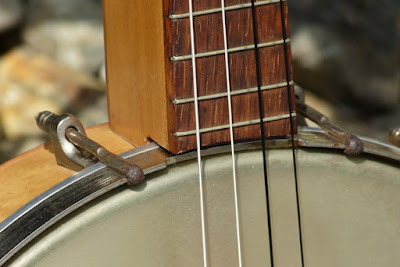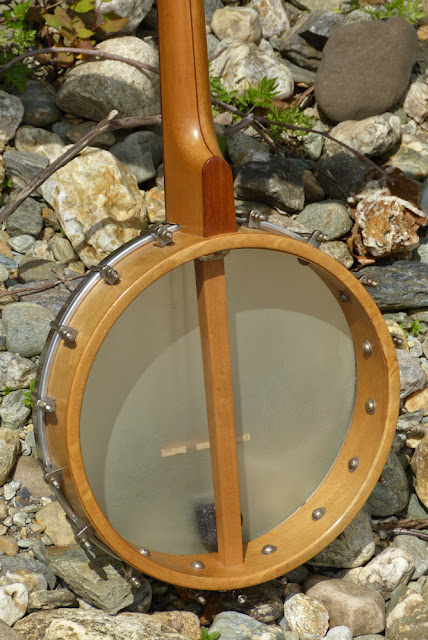1920s Gretsch-made Tenor Banjo/Baritone Banjo Ukulele
I've worked on a lot of variations of this basic Gretsch-made tenor banjo design (often branded "Clarophone") and the general rule of thumb on them seems to be that the older they get, the shorter the scale length. At 19 3/4" this one is on the short-end of a tenor banjo and that invited me to set it up like a "baritone ukulele banjo" -- something that is gaining traction in the market, these days, in new instruments. 19-20" is standard for a bari and so it fits. I've set a few short-scale tenors up this way for customers in the past and I thought it'd be fun to do this one that way, too -- and it was!
This has a good, warm, chunky sound to it that really suits the nylon strings and DGBE tuning. It works as a "jazzy strummer" and "fingerpicker," equally. The head is 10 7/8" and it has a multi-ply maple rim with a bigger round-hoop tonering on its top edge.
Someone had done some upgrading to the instrument in the past, including a new armrest, new Remo Renaissance-style head, and new adjustable tailpiece. I finished-up the work that needed-doing including a fret level/dress, new bone nut, better bridge, cleaning, and general setup. I also swapped the tuners to some old, parts-bin uke-issue 1920s Champion friction pegs.
The look is clean and simple and nicely "natural."
The headstock veneer is Brazilian rosewood and the fretboard is, too. Typically on old Gretsch-made banjos, this was stained/ebonized maple, so it's nice to see "the real stuff."
The nut width is 1 1/8" and the neck has a comfortable, medium-C shape to its rear. The board itself is flat.
Pearl dots and smallish old-style frets. They have lots of life left, however. The neck is dead-straight, too.
An armrest is always nice to have.
The little "volute" is a typical feature of Gretsch-made banjos through the 20s and early 30s. The old Champion uke pegs have buttons that show some shrinkage-cracking, though they're stable and good to go.
I always liked the look of the small-button Champions that came standard with ukes. I removed the extra washers that usually come with these pegs and as a result they turn more-smoothly than usual and the 1:1 ratio is "at home" for most vintage-instrument bari-uke players.
For a few years, Gretsch used this simple 3-screw neck plate/brace that attaches the neck with screws. Aside from a coordinator rod design, I firmly believe a simple "screw attachment" like this is the most rugged and practical way to secure a banjo neck on a rim.
Anything otherwise-adjustable tends to loosen-up and in the past 2 years I've simply been removing shim-adjusted and bar-adjusted neck braces off of lower-to-mid banjos and replacing them with a simple bolt and glorified washer -- it's just so much easier to maintain for the average player who doesn't ever want to think of adjusting anything other than tightening the head once in a while.
I put a small wad of foam material to mute overtones. It's wedged-up against the head under the tailpiece to hide it from the front. You can also see that healthy-sized hoop tonering in these pics.
Some of the "rim cap" footer maple veneer has expanded/shrunk/moved and been reglued off from the side of the rim. Honestly -- there's not much else to do, so I understand why it was left this way. This is a common issue on banjos with this type of bottom-edge.
Aside from the head, tail, armrest, and bridge, the rim hardware appears all-original.


















Comments